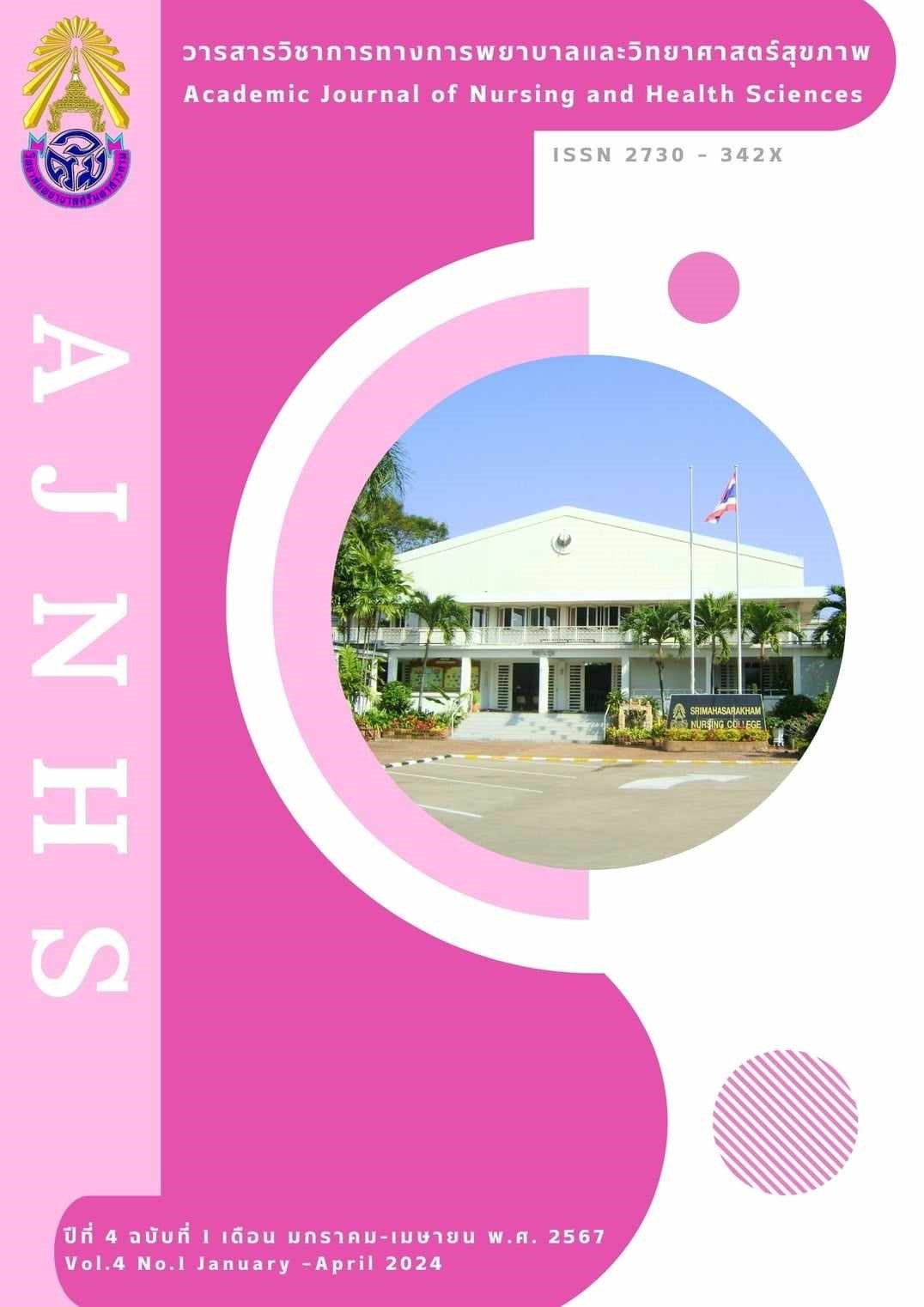The Development of Care Approaches for Treating Drug Users with Depression
Keywords:
Drug user, DepressionAbstract
This research is an action research study aimed at examining the situation of drug users with depression, developing care strategies for treating drug users with depression, and evaluating the effectiveness of these care strategies. The population consists of drug users with depression ranging from mild to severe, all of whom are in the Huakwang sub-district, Kosumphisai district, Maha Sarakham province. The tools used include care strategies for treating drug users with depression, a 2-question (2Q) depression screening, a 9-question (9Q) depression screening, an 8-question (8Q) suicide assessment, a stress assessment (ST-5), and a self-esteem questionnaire scores. The statistics used in data analysis are percentage, mean, standard deviation, Chi-Square Test, and Paired t-test.
The research found that depression screening with 2 questions (2Q) among drug users with depression after participating in the care strategy development program had a positive effect on screening, reducing from 24 to 11 cases, which is 45.8%. The comparison of depression screening with 9 questions (9Q) among drug users with depression before and after participation showed a statistically significant mean score reduction (Mean difference = 6.92, 95%CI 5.77-8.06, p-value<0.05). The stress assessment (ST-5) scores after participation also significantly decreased (Mean difference = 4.46, 95%CI 3.69-5.23, p-value<0.05). The self-esteem questionnaire scores increased significantly after participation (Mean difference = -0.78, 95%CI -0.99 to -0.56, p-value <0.05), but the suicide assessment (8Q) scores before and after participation did not differ significantly.
The study concluded that after drug users with depression participated in the care strategy development program, they experienced increased self-esteem, and improved depression and stress screening results. Therefore, this care approach should be continuously used and disseminated for use in community health-promoting hospitals or other hospitals.
References
กรมสุขภาพจิต กระทรวงสาธารณสุข. (2563). คู่มือระบบการดูแลผู้ป่วยจิตเวชที่มีความเสี่ยงสูงต่อการก่อความรุนแรงสำหรับสถาบัน/โรงพยาบาล สังกัดกรมสุขภาพจิต. นนทบุรี : พรอสเพอรัสพลัส.
เพ็ญพักตร์ อุทิศ, สุนิศา สุขตระกูล, กงจักร สอนลา,และมะลิ แสวงผล. (2561). ปัจจัยที่สัมพันธ์กับอาการของโรคซึมเศร้าในวัยรุ่นที่เสพยาบ้า.วารสารวิชาการสาธารณสุข, 27(6), 965-977.
สุพรรษา พูลพิพัฒน์,อังศินันท์ อินทรกำแหง, และสุภาพร ธนะชานันท์. (2556). ผลของโปรแกรมการปรับพฤติกรรมทางปัญญาที่มีต่อภาวะซึมเศร้าในผู้ป่วยยาเสพติด.วารสารพฤติกรรมศาสตร์เพื่อพัฒนา, 5(1), 241-254.
Bao YP, Qiu Y, Yan SY, Jia ZJ, Li SX, Lian Z, et al.Pattern of drug use and depressive symptoms amongamphetamine type stimulants users in Beijing and Guangdong province, China. PLOS ONE [Internet]. 2013[cited 2023 Aug 10];8:e60544. Available from: https://www.ncbi.nlm.nih.gov/pmc/articles/PMC3621819/pdf/pone.0060544.pdf
Conway KP, Compton W, Stinson FS, Grant BF. (2006). Life-time comorbidity of DSM-IV mood and anxiety disor-ders and specific drug use disorders: Results from the National Epidemiologic Survey on Alcohol and Related Conditions. J Clin Psychiatry, 67, 247–57.
Glasner-Edwards S, Marinelli-Casey P, Hillhouse M,Ang A, Mooney LJ, Rawson R.(2009). Depression among meth-amphetamine users: association with outcomes from the Methamphetamine Treatment Project at 3-year follow-up. J Nerv Ment Dis,197,225-31.
Hall W, Hando J, Darke S, Ross J. (1996). Psychological mor-bidity and route of administration among amphetamineusers in Sydney, Australia. Addiction,91, 81–7.
Khantzian M.(1997).The self-medication hypothesis of sub-stance use disorders: A reconsideration and recent applications. Harvard Review of Psychiatry, 4, 231-44.
London ED, Simon SL, Berman SM, Mandelkern MA,Lichtman AM, Bramen J, et al. (2004). Mood disturbances andregional cerebral metabolic abnormalities in recently ab-stinent methamphetamine abusers. Arch Gen Psychiatry,61, 73-84.
Markou A, Kenny PJ. (2002).Neuroadaptations to chronic ex-posure to drugs of abuse: relevance to depressive symptomatology seen across psychiatric diagnostic categories.Neurotox Res, 4, 297–313.
Sutcliffe CG, German D, Sirirojorn B, Latkin C,Aramrattana A, Sherman SG, et al.(2009). Patterns of metham-phetamine use and symptoms of depression among youngadults in northern Thailand. Drug Alcohol Depend,101,146–51.
United Nations Office on Drugs and Crime. (2017). 29.5 million people globally sufferfrom drug use disorders, opioids the most harmful. Retrieved January 19, 2023. From https:// www.unodc.org/unodc/en/data-and-analysis/wdr2021.htm
Downloads
Published
How to Cite
Issue
Section
License

This work is licensed under a Creative Commons Attribution-NonCommercial-NoDerivatives 4.0 International License.

